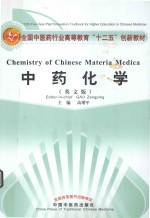图书介绍
新世纪全国高等中医药院校创新教材 中药化学 英文版PDF|Epub|txt|kindle电子书版本网盘下载

- 高增平主编 著
- 出版社: 北京:中国中医药出版社
- ISBN:9787513219334
- 出版时间:2014
- 标注页数:453页
- 文件大小:47MB
- 文件页数:470页
- 主题词:中药化学-中医学院-教材-英文
PDF下载
下载说明
新世纪全国高等中医药院校创新教材 中药化学 英文版PDF格式电子书版下载
下载的文件为RAR压缩包。需要使用解压软件进行解压得到PDF格式图书。建议使用BT下载工具Free Download Manager进行下载,简称FDM(免费,没有广告,支持多平台)。本站资源全部打包为BT种子。所以需要使用专业的BT下载软件进行下载。如BitComet qBittorrent uTorrent等BT下载工具。迅雷目前由于本站不是热门资源。不推荐使用!后期资源热门了。安装了迅雷也可以迅雷进行下载!
(文件页数 要大于 标注页数,上中下等多册电子书除外)
注意:本站所有压缩包均有解压码: 点击下载压缩包解压工具
图书目录
PART ONE BASIC PRINCIPLES3
Chapter 1 General Introduction to Chemistry of Chinese Materia Medica3
1 The Conception of Chemistry of Chinese Materia Medica3
2 The Application of Chemistry of Chinese Materia Medica4
2.1 To Clarify Effective Compositions of Chinese Herbs4
2.2 To Facilitate the Development of New Drugs5
3 The Progress of Chemistry of Chinese Materia Medica6
3.1 Development in Identification of Effective Compositions of Chinese Herbs6
3.2 The New Development in Drug Research and Pharmaceutical Industry7
3.3 The Progress in Quality Control of Chinese Herbs and their Preparations7
Chapter 2 General Methods for Chemical Investigation of Chinese Herbs10
1 The Biosynthetic Pathways and Classification of Chemical Constituents from Chinese Herbs10
1.1 Biosynthetic Pathways11
1.2 Classification of Chemical Constituents11
2 The General Methods for Chemical Investigation13
2.1 Extraction Methods13
2.2 Isolation Methods22
2.3 Structure Determination Methods32
Chapter 3 Carbohydrates and Glycosides47
1 Carbohydrates47
1.1 Introduction47
1.2 Structure and Classification47
1.3 The properties of carbohydrates54
2 Glycosides56
2.1 Introduction56
2.2 Structure and Classification56
2.3 General Physicochemical Properties62
3 Extraction and Isolation Methods69
3.1 Extraction Methods69
3.2 Isolation Methods72
4 Identification74
4.1 Physicochemical Identification74
4.2 Chromatography Identification75
5 Structure Determination75
5.1 Determination of Physical Constants75
5.2 Determination of Molecular Formula and Molecular Weight76
5.3 Identification of Aglycones and Saccharides76
5.4 Determination of the Linkage Sequence and Position in the Saccharide Moiety78
5.5 Determination of the Configuration of Glycosidic Linkage80
Chapter 4 Quinones83
1 Introduction83
2 Structure Characteristics and Classification83
2.1 Benzoquinones83
2.2 Naphthoquinones84
2.3 Phenanthraquinones85
2.4 Anthraquinones85
3 Physical and Chemical Properties88
3.1 Physical Properties88
3.2 Chemical Properties89
4 Extraction and Isolation Methods92
4.1 Extraction Methods92
4.2 Isolation Methods92
5 Identification94
5.1 Physicochemical Identification94
5.2 Chromatography Identification94
6 Structure Elucidation94
6.1 Chemical Methods94
6.2 Spectroscopic Analysis of Anthraquinones95
Chapter 5 Phenylpropanoids101
1 Introduction101
2 Simple Phenylpropanoids102
2.1 Structure and Classification102
2.2 Extraction and Isolation Methods102
3 Coumarins103
3.1 Introduction103
3.2 Structure and Classification104
3.3 General Physicochemical Properties106
3.4 Extraction and Isolation Methods108
3.5 Identification109
3.6 Structure Determination109
4 Lignans111
4.1 Introduction111
4.2 Structure and Classification111
4.3 General Physicochemical Properties114
4.4 Extraction and Isolation Methods115
4.5 Identification116
4.6 Structure Determination116
Chapter 6 Flavonoids120
1 Introduction120
1.1 Definition of Flavonoids120
1.2 Distribution of Flavonoids120
1.3 Pharmacological Activities of Flavonoids121
1.4 The Biosynthesis of Flavonoids121
2 Structure and Classification122
2.1 Flavonoid Aglycones122
2.2 Flavonoid Glycosides128
3 Physical and Chemical Properties129
3.1 Physical Properties129
3.2 Chemical Properties130
4 Extraction and Isolation Methods133
4.1 Extraction Methods133
4.2 Isolation Methods133
5 Identification136
5.1 Physicochemical Identification136
5.2 TLC Identification136
6 Structure Elucidation137
6.1 UV137
6.2 NMR140
6.3 MS146
6.4 An Example for Structural Determination of Flavonoids149
Chapter 7 Tannins154
1 Introduction154
2 Structure and Classification156
2.1 Hydrolysable Tannins156
2.2 Condensed Tannins159
2.3 Complex Tannins160
3 General Physicochemical Properties161
3.1 Physical Properties161
3.2 Chemical Properties161
4 Extraction and Isolation Methods161
4.1 Extraction Methods161
4.2 Isolation Methods161
5 Identification163
6 Structure Determination164
6.1 1H-NMR164
6.2 13C-NMR165
6.3 MS165
6.4 CD165
Chapter 8 Alkaloid&s168
1 Introduction168
1.1 Definition of Alkaloids168
1.2 Distribution of Alkaloids168
1.3 Pharmacological Activities of Alkaloids169
2 Structure and Classification169
3 Physical and Chemical Properties171
3.1 Physical Properties171
3.2 Chemical Properties172
4 Extraction and Isolation Methods177
4.1 Extraction of Alkaloids177
4.2 Isolation of Alkaloids178
5 Identification183
5.1 Chemical Tests183
5.2 Chromatography Methods184
6 Structure Determination184
6.1 Chemical Methods184
6.2 Spectroscopy Methods185
Chapter 9 Steroids189
1 Introduction189
1.1 Defination and Classification of Steroids190
1.2 Color Reactions of Steroids190
2 Cardiac Glycosides191
2.1 Introduction191
2.2 Structures and Classification191
2.3 Relationship between Structures of Cardiac Glycosides and Their Cardiac Activities193
2.4 Physical and Chemical Properties194
2.5 Extraction and Isolation of Cardiac Glycosides198
2.6 Identification of Cardiac Glycosides199
2.7 Spectroscopic Characters of Cardiac Glycosides200
3 Bile Acids206
3.1 Introduction206
3.2 Structure Characters of Bile Acids207
3.3 Main Properties of Bile Acids207
3.4 Identification of Bile Acids208
3.5 Extraction and Isolation of Bile Acids208
4 C21-Steroids208
5 Phytosterols209
Chapter 10 Terpenoids and Volatile Oils212
1 Terpenoids212
1.1 Introduction212
1.2 Classification and Representatives of Terpenoids214
1.3 Physical and Chemical Properties225
1.4 Extraction and Isolation Methods228
1.5 Identification229
1.6 Structure Determination230
2 Volatile Oils231
2.1 Introduction231
2.2 The Composition232
2.3 Physical and Chemical Properties233
2.4 Extraction and Isolation Methods234
2.5 Identification236
Chapter 11 Saponins239
1 Introduction239
2 Structure Characters and Classification239
2.1 Steroidal Saponins240
2.2 Triterpenoid Saponins243
3 Physical and Chemical Properties249
3.1 Physical Properties249
3.2 Chemical Properties250
3.3 Hemolysis Property251
4 Extraction and Isolation Methods252
4.1 Extraction Methods252
4.2 Isolation Methods253
5 Identification254
5.1 Physical and Chemical Identification254
5.2 Chromatography Identification254
6 Structure Elucidation254
6.1 UV255
6.2 IR255
6.3 MS255
6.4 NMR259
Chapter 12 Other Constituents264
1 Fatty Acids264
1.1 Introduction264
1.2 Structure Characters and Classification265
1.3 Physical and Chemical Properties267
1.4 Extraction and Isolation Methods267
2 Organic Sulphur Compounds267
2.1 Introduction267
2.2 Organic Sulphur Compounds from Chinese Herbs268
3 Amino Acids,Proteins,and Enzymes268
3.1 Amino Acids268
3.2 Proteins and Enzymes270
4 Minerals271
4.1 Introduction271
4.2 Examples of Mineral271
PART TWO APPLICATIONS279
Chapter 13 Examples of Chinese Herbs279
Lycii Fructus(Gouqizi)279
Armeniacae Semen Amarum(Kuxingren)284
Rhei Radix et Rhizoma(Dahuang)286
Salviae Miltiorrhizae Radix et Rhizoma(Danshen)290
Arnebiae Radix(Zicao)292
Fraxini Cortex(Qinpi)294
Schisandrae Chinensis Fructus(Wuweizi)297
Forsythiae Fructus(Lianqiao)299
Scutellariae Radix(Huangqin)302
Puerariae Lobatae Radix(Gegen)305
Sophorae Flos(Huaihua)308
Ginkgo Folium(Yinxingye)311
Galla Chinensis(Wubeizi)316
Cinnamomi Cortex(Rougui)318
Ephedrae Herba(Mahuang)321
Coptidis Rhizoma(Huanglian)325
Daturae Flos(Yangjinhua)331
Sophorae Flavescentis Radix(Kushen)336
Stephaniae Tetrandrae Radix(Fangji)340
Corydalis Rhizoma(Yanhusuo)343
Periplocae Cortex(Xiangjiapi)346
Bufonis Venenum(Chansu)351
Bovis Calculus(Niuhuang)357
Artemisiae Annuae Herba(Qinghao)358
Andrographis Herba(Chuanxinlian)362
Rehmanniae Radix(Dihuang)366
Menthae Haplocalycis Herba(Bohe)369
Ginseng Radix et Rhizoma(Renshen)372
Glycyrrhizae Radix et Rhizoma(Gancao)380
Bupleuri Radix(Chaihu)385
Ophiopogonis Radix (Maidong)391
Allii Sativi Bulbus(Dasuan)396
APPENDICES403
Appendix Ⅰ Glossary403
Appendix Ⅱ Latin Names442
Appendix Ⅲ Abbreviations for Commonly Used Solvents453